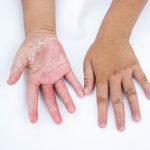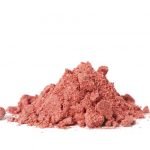Vis Medicatrix Naturae
Deborah Frances, RN, ND
Chris Chlebowski, DC, ND
Finding the right homeopathic remedy can seem daunting, but cases are often resolved by simple polycrest prescribing. Hopefully this series of articles will serve to inform and inspire the homeopath within us all. Fortunately, herbal medicine is more forgiving.
Post-Surgical Pain in an Infant
Dr Chlebowski
An infant seen in Dr Chlebowski’s clinic a few days after birth for feeding problems was treated with craniosacral therapy and Network Chiropractic, which offered some relief but did not solve the problem. He was seen again 2 weeks later after receiving laser therapy to release his tongue, which the pediatrician had determined was the source of the problem.
Since the surgery, the infant had more difficulty feeding. He cried and kicked every time he tried to latch onto the breast, suggesting pain at the surgical site, and he had lost 9 ounces in the 3 days following surgery.
Examination was negative. Repertorization was completed using 2 rubrics:
MOUTH-INJURIES – Tongue; CALEN, aloe, arn, Carb an, merc
MOUTH-INJURIES – Tongue-laceration: CALEN
The infant was given 1 dose of Calendula 200C. The next day he was nursing better, latching normally and no longer exhibiting distress with feeding. He rapidly began gaining weight and there were no further problems with feeding.
Calendula is in the same plant family as 2 other remedies commonly used in the treatment of wounds: and Bellis perennis.
A Case of Acute Balanitis
Dr Chlebowski
A 5-year-old boy was brought to the clinic with a purulent discharge of 3 months’ duration, which was exuding from under the foreskin of his penis. Symptoms had started when an eruption seeping a yellowish exudate appeared under his nose. Five days later he developed a blister on the tip of his foreskin. The mother consulted 2 different physicians. Both made a diagnosis of impetigo and recommended antibiotics. The mother elected to not do this, instead using topical applications of grapefruit seed extract, acidophilus, and apple cider vinegar. The eruption on the boy’s face cleared with the home remedies; however, the problem with his penis only worsened. She then consulted a urologist, who diagnosed the problem as scar tissue when she was unable to retract the foreskin. An appointment was scheduled for circumcision, which the mother hoped to avoid.
Pain and itching under the foreskin were intermittent and of varying intensity, but at times the child’s discomfort was so bad he would cry and dance about, holding his penis in obvious pain.
Examination revealed an enlarged, erythematous glans penis under the foreskin. A milky-white discharge, accompanied by a few drops of bright red blood, exuded from under the foreskin. The shaft was red and irritated and the foreskin could not be retracted.
Despite his discomfort, the child was sweet and cooperative in the office and his mom described him as soft-spoken, easygoing, and affectionate – all personality characteristics suggestive of Pulsatilla. But repertorization brought up a smaller remedy, Jacaranda, the only remedy listed in the rubric:
MALE GENITALIA/SEX-INFLAMMATION – penis-glans pus; with- Prepuce; under: Jac-c
Both Boericke1 and Clarke2 write that Jacaranda is indicated with “heat and pain of the penis.” Clarke adds that the “prepuce cannot be drawn back… [and there is] suppuration between glans and prepuce.”
Roger Morrison, who generated the rubric, has only 1 sentence to describe Jacaranda in his materia medica3:
In cases of balanitis with pus under the foreskin, Jacaranda is nearly a specific.
How much closer to the Simillimum could we get? The child was given Jacaranda 30C, to be taken 3 times daily along with 2000 mg of vitamin C, as well as directions for penis soaks in silver hydrosol, to be done twice daily for 1 minute each time.
There was marked improvement within 24 hours, with an 80% decrease in swelling and discharge. The 30C was plussed and was repeated 3 days later when a slight suggestion of discharge and swelling returned.
On follow-up 10 days later, symptoms were completely gone, and the urinalysis, which previously showed high leukocytes, was completely clear.
Another Case of Impetigo
Dr Frances
An 8-year-old girl was brought to clinic with an eruption on the left side of her face, consistent with impetigo. Vesicles were present on a red, acrid base, and thin scabs were evident in areas where the girl had scratched. Scratching relieved the itching, but led to burning and a moist discharge. Heat aggravated the itching, and the whole business left the child weepy, irritable, and snappish – a definite change from her usually reserved nature.
The mother was instructed to make a paste by mixing cod liver oil with zinc oxide, to apply topically, and Sepia 30C was dispensed, to be taken every 4 hours.
On follow-up 24 hours later, the sensations of itching and burning were gone and the mom reported that the eruption was less red. The dosage of Sepia was reduced to 3 times daily, with a recommendation to decrease frequency of repetition as symptoms improved or to increase repetition if symptom improvement stalled or the eruption worsened. The condition continued to improve quickly over another 24 hours, at which time progress stalled and the eruption began to itch again. The potency of Sepia was increased to 200C every 8 hours as needed, again following the symptoms. The impetigo resolved quickly after 2 doses of Sepia 200C, given 24 hours apart.
Sepia is a highly effective remedy for skin conditions when symptoms fit. It is one of several remedies for skin eruptions arising after exposure to poison oak. Bryonia (dry eruption) Sulphur, Rhus tox, Croton tiglium, Anacardium, and Apis are other remedies to consider for poison oak.
Although Sepia did not repertorize well, it is a complement to Natrum muriaticum,4 a remedy that had helped this girl constitutionally.
A Case of Vaccinosis
Dr Frances
A 2-year-old girl was brought to clinic for non-rheumatoid pain and inflammation in her joints that rheumatologists were at a loss to tie to a definitive diagnosis. Usually bright eyed and vivacious, this little girl now spent most of her day whimpering and crying.
History revealed that the child had received several vaccines a few days before the onset of her symptoms. No other significant stressors were identified.
Since her symptoms were worse at rest and on first moving and were better with continued motion, a prescription of Rhus tox seemed like the obvious place to start. Pulsatilla has the same modalities, ie, “worse repose”5 and “worse after having been seated a long time.”6 Both remedies are present in the rubric VACCINATIONS, reactions ailments from.7 Since the child’s basic nature was bold, curious, and mischievous, with rarely a trace of shyness, it did not occur to me to consider Pulsatilla, although the change in state may well have warranted its use.
The only treatment given was Rhus tox 200C, once daily for 3 days. The child recovered quickly, with no relapses, and the mother was advised to avoid further vaccines for this child.
Another child did not fare so well. It took a full year to restore this little boy’s health after the administration of 9 vaccines at once left him with recurrent bronchitis and otitis media. This formerly healthy 3-year-old improved gradually with repeated doses of Sulphur. He was also kept on nutritional and herbal immune support, and was kept off offending foods that had not been an issue for him prior to vaccination.
Pertussis
Dr Frances
The violently spasmodic cough typical of pertussis can be exhausting for children and parents alike, especially since it is most often worse at night.
A simple formula of herbs (Table 1) has proven highly efficacious at mitigating symptoms and allowing everyone to get more sleep while the disease rests its course. Dosage should be adjusted for each child using Clarke’s Rules (Table 2).
Table 1. Herbal Formula for Pertussis
| Herb & Dosage | Action |
| Lobelia (5 mL) | Antispasmodic, low-dose herb |
| Verbascum (15 mL) | Antispasmodic, demulcent |
| Glycyrrhiza (10 mL) | Antispasmodic, demulcent, anti-inflammatory, antimicrobial, adaptogenic |
Table 2. Clarke’s Rule
| Child’s weight ÷ 150 ✕ normal adult dose (30 drops for this formula) |
The basic formula can be adapted to include other herbs, such as Thymus, Prunus, Trifolium, or Grindelia; however, the percentage of Lobelia in the formula should remain constant at 5 mL per ounce. The number of doses should be limited to no more than 10 in any 24-hour period. Excessive dosing of Lobelia will lead to nausea and vomiting.
Gruel made from Althea officinalis (Table 3) will provide moistening, demulcent, and anti-inflammatory properties, as well as mild antispasmodic actions. Frequent large doses of the gruel can be taken safely, and the herbs should be dosed freely for best results. The use of Althea is preferable to slippery elm, as it is more ecologically sustainable and works just as well for protecting and healing mucous membranes.
Table 3. Althea Gruel
|
· Slowly stir ¼ cup of cold juice or water into 1 ½ to 2 tsp of powdered Althea root to make a paste · Add 1 ½ to 2 cups of boiling water or juice, stirring steadily · Cinnamon, raisins, honey, or other seasonings may be added for flavor · Dose freely, up to 6 or more cups per day. This herb is quite safe. |
The parents should be placed on a formula of adaptogens to support their own health during the worry and stress of dealing with child’s illness. A tincture of adaptogens should be dosed at 30-60 drops 3 times daily.
Once the child has recovered, is it wise to keep them on a formula of lung-nourishing herbs (eg, Althea, Verbascum, and Glycyrrhiza) for several months to help rebuild the lungs and bronchi. An episode of pertussis can sometimes leave lung tissues vulnerable and more prone to pneumonia.
Pertussis is most dangerous to infants whose immune systems are too immature to respond to the vaccine. Most children recover fully from the disease.
A Case of Suppression
Dr Frances
A 3-month-old female, brought into the office for a loose cough and free-flowing, clear nasal discharge, was diagnosed with a viral upper respiratory infection and mild serous otitis media (OM). Pulsatilla 30C was dispensed, to be given every 4 hours based on the loose quality of the cough. Pulsatilla is the first remedy to consider for a loose cough at any age, especially if the cough is worse in the evening or accompanied by yellow discharge. Dry cough may also be helped by Pulsatilla when symptoms fit. The presence of conjunctivitis nearly always calls for Pulsatilla. A cough formula containing Echinacea, Prunus, Verbascum, Inula, Hydrastis, Eriodictyon, Ligusticum, and Zingiber was also dispensed, to be given at 5 drops every 2 hours for 48 hours while awake, then every 4 hours.
On phone follow-up 24 hours later, the mother reported that the baby was less fussy and sleeping better. The cough was less frequent and the coryza less copious.
A few days later, the mother called to say the child was worse, fussier than before. “Her nose is so plugged she can hardly nurse. I went up to a 200C Pulsatilla, but it’s done nothing.”
Examination revealed significantly more fluid behind the much redder tympanic membrane and no light reflex.
On the initial visit, both bronchial and nasal discharge were loose and flowing freely. The Pulsatilla had clearly been helping. It appeared that the worsening of her OM was related to the now-blocked nasal discharge.
Close questioning was unrevealing until the mother remembered that she had changed the cough formula to one she’d picked up at the health food store.
One of the ingredients in the new herbal cough formula was Salvia officinalis, a very drying herb. Full of hormone-modulating saponins, Salvia is a great herb for recalcitrant menopausal hot flashes with exhaustive sweating, but is contraindicated in any condition where a discharge is essential to the process of healing. I had the mom stop the new formula and repeat the Pulsatilla 200C. This time the remedy worked. On phone follow-up the next day, the mother reported that the mucus was again flowing freely from the nose, the baby was nursing normally and much happier.
This case illustrates the difference between using natural therapies and using them wisely. We are blessed as naturopathic physicians to have a philosophy that cautions us to avoid suppression by treating underlying causes (Tolle Causam) and honoring symptoms as the body’s attempt to heal (Vis Medicatix Naturae). Salvia is an herb to watch for in OTC herbal cough formulas aimed at allopathically drying up the mucus in respiratory illnesses.
References:
- Boericke W. Materia Medica with Repertory. Santa Rosa, CA: Boericke and Tafel Inc; 1927:286.
- Clarke JH. A Dictionary of Practical Materia Medica, Volume II. New Delhi, India: Jain Publishing; 2010:62.
- Morrison R. Desktop Guide to Keynotes and Confirmatory Symptoms. Grass Valley, CA: Hahnemann Clinic Publishing; 1993:194.
- Boericke W. Materia Medica with Repertory. Santa Rosa, CA: Boericke and Tafel Inc; 1927:370.
- Clarke JH. A Dictionary on Practical Materia Medica, Volume III. Santa Rosa, CA: New Delhi, India; Jain Publishing; 2010:923.
- Clarke JH. A Dictionary on Practical Materia Medica, Volume III. Santa Rosa, CA: New Delhi, India; Jain Publishing; 2010:924.
- Murphy R. Homeopathic Clinical Repertory, 3rd ed. Blacksburg, VA: Lotus Health Institute; 2005:2257.
Image Copyright: <a href=’https://www.123rf.com/profile_sam74100′>sam74100 / 123RF Stock Photo</a>
 Deborah Frances, RN, ND, practiced homeopathy and nutrition as a registered nurse before graduating from NCNM (now NUNM) in 1993. She practiced in rural Oregon for several years before returning to Portland to teach at NCNM. Dr Frances has been a popular lecturer at conferences around the country and has taught as adjunct faculty at both NCNM and Bastyr. She has taught classes on herbal medicine, acute prescribing for NDs, dream work, and shamanic healing. She is strongly influenced by the traditional teachings of her Lakota ancestry. Dr Frances is the author of Practical Wisdom in Natural Healing, available at drdeborahfrances.wordpress.com.
Deborah Frances, RN, ND, practiced homeopathy and nutrition as a registered nurse before graduating from NCNM (now NUNM) in 1993. She practiced in rural Oregon for several years before returning to Portland to teach at NCNM. Dr Frances has been a popular lecturer at conferences around the country and has taught as adjunct faculty at both NCNM and Bastyr. She has taught classes on herbal medicine, acute prescribing for NDs, dream work, and shamanic healing. She is strongly influenced by the traditional teachings of her Lakota ancestry. Dr Frances is the author of Practical Wisdom in Natural Healing, available at drdeborahfrances.wordpress.com.
 Chris Chlebowski, DC, ND, is a homeopath, chiropractor, and naturopathic physician. Dr Chlebowski graduated from Western States Chiropractic College in 2007 and from NCNM in 2011. He and his family live and work in Ashland, OR, where he owns and operates an integrative clinic focused on the treatment of difficult, chronic disease. Although his work is always built on a firm foundation of homeopathy, botanical medicine, and nutrition, he also utilizes hyperbaric oxygen, IV therapies, and many other modalities.
Chris Chlebowski, DC, ND, is a homeopath, chiropractor, and naturopathic physician. Dr Chlebowski graduated from Western States Chiropractic College in 2007 and from NCNM in 2011. He and his family live and work in Ashland, OR, where he owns and operates an integrative clinic focused on the treatment of difficult, chronic disease. Although his work is always built on a firm foundation of homeopathy, botanical medicine, and nutrition, he also utilizes hyperbaric oxygen, IV therapies, and many other modalities.





